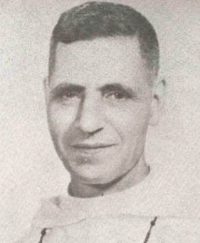Today, Sunday, I shall speak in vague terms, as the New Regime is wont to do, with regard to religion and the Church. Up to now, the military authorities have not yet made it clear what their definite plans are, if they have any, about their relationship with the Church. Nor have they attempted to solve the religious problem, if there is any.
In one of the first flying propaganda leaflets which the Japanese planes sometimes drop instead of bombs over Manila in order to draw the people to them and alienate them from the Americans, there appeared the following: “And may God, who came from the Orient, bless you.”
A newspaper photo showed about a dozen Japanese soldiers seated in a church filled with faithful, and captioned, “Japanese soldiers hearing Mass in a Catholic Church together with Filipinos.” This has been the common scene in the provinces and in Manila. Still another photo showed a church intact, in an isolated place, captioned, “The Japanese Air Force, in destroying all military objectives, took maximum care in leaving intact the churches and centers of culture.”
I have only to look out the window and see this College and those of Sta. Catalina and Sta. Rosa with their respective chapels, the Intramuros Elementary School, the Sto. Domingo Church and convent, to see how these churches and centers of culture have been reduced to mounds of debris, and to convince myself that it is easier to catch a liar than a lame man.
The Prime Minister of Japan, General Tojo, and the Commander-in-Chief of the Japanese Imperial Army in the Philippines, whom nobody knows, reiterated their assurances that they would respect religious beliefs in occupied countries. They are exerting efforts to strengthen the spiritual ties existing among the Filipinos and the Japanese as Orientals. However, they have not embarked on the details of how they think of intensifying this Oriental spirituality, not specified how they are to discard what they condemn as the materialistic Anglo-Saxon way of life.
This is what they said, but what have they done? In a broad sense, one could say that they comply with their commitments. There are cases, few and isolated ones, of some priests being maltreated either by mistake or by ignorance, after which apologies were offered. Priests and religious have been treated differently, and they have repeatedly told us that the habit or the cassock is the best protection and the best pass in going about the city.
A number of American religious who were interned in Sto. Tomas were released after a few days. The religious of other enemy countries were less molested though their buildings were occupied by the army, as was the case of San Beda and La Salle. The Jesuits were gathered together at the Ateneo in Padre Faura and the Americans were locked up in voluntary seclusion to prevent the Japanese from occupying the building.
When the Japanese Army came to this country they brought along with them a Commission on Religion, composed of Buddhist monks, Protestant ministers and two Catholic priests with two seminarians, all of whom were Japanese. The head of the group was a Buddhist monk and they installed themselves at the Ateneo. The Catholic priests wanted to use San Ignacio Church, but as no one attended their services, they changed their plans. They went instead from parish to parish within the city, celebrating Mass and preaching. The Protestant minister did the same. The two seminarians, on the other hand, were more interested in learning Spanish and they went to the convents almost every afternoon carrying their grammar books, practicing and murdering the Spanish language. Although they were dressed in army uniforms, they were not army chaplains, as the Japanese Army had none, but rather liaisons of the army with the civilian populace.
The mission of the Commission on Religion seems to be two-fold; first, to enable the religious authorities in the Philippines to take up matters with the military authorities through the Commission; second, to make propaganda and create an atmosphere favorable to the New Regime.
Their first sermon was delivered at the Sta. Cruz Church on the Feast of the Three Kings. The preacher reminded the people that the Three Kings came from the Orient to adore the Savior, who, after revealing Himself to them, made them emissaries of the new dispensation before all nations. “In the same way,” the preacher continued, “we came from the Empire of the Rising Sun to bring you a new culture, a new spiritual life, which originated from the Orient, etc., etc.”
With respect to their attitude towards the reopening of Catholic schools, we still lack data on which to form a judgment. We cannot tell if they will permit the schools to function or impose strict conditions, as they do in Japan where Catholic schools are under close observation and foreigners are not allowed to teach in or operate such schools. Many are worried about the future of our colleges.
